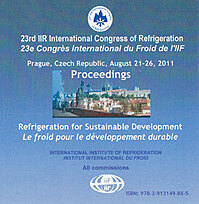
IIR document
Performance of solar sorption cooling systems with heat rejection assisted by a latent heat storage.
Number: pap. ID: 659
Author(s) : HAGEL K., HELM M., SCHWEIGLER C.
Summary
In present state absorption cooling installations, wet cooling towers designed for a coolant supply/return temperature 27/35°C are applied. Yet, especially in small scale absorption cooling installations wet cooling towers are unattractive due to the required effort for maintenance, water make-up and the risk of legionella growth and propagation. As an alternative a dry air cooler can be applied, requiring only marginal maintenance. But the reject heat supply and return temperature has to be increased up to 40/45°C at peak load conditions. As a consequence the cooling capacity of the absorption chiller decreases by more than 50% when the driving heat temperature is limited to the level required for operation with a wet cooling tower with moderate cooling water temperatures. To provide the same chilling capacity a higher driving temperature level is requested. Due to the poor efficiency of flat plate solar thermal collectors under these conditions the size of the collector field has to be enlarged accordingly. Furthermore, the application of standard hydraulic components is limited to system temperatures below 100°C. To avoid a decrease of chilling capacity due to an increased temperature level of the coolant, a latent heat storage can be installed in series to the dry air cooler ensuring a coolant return temperature of 32°C even at higher ambient temperature. In case the dry air cooler cannot release the total rejected heat, the latent heat storage provides a stable return temperature level for absorber and condenser of the chiller by storing the remaining rejected heat. The stored energy is then dissipated during night-time, when more favourable ambient conditions are available. As phase change material for the latent heat storage, a salt hydrate with a melting point in a temperature range between 28 and 29°C has been chosen. Motivated by promising results of a pilot installation serving an office building in Garching (near to Munich, Germany) additional analyses for other European climatic regions have been performed. Based upon the operational results a Simulink model has been developed. Beyond the characteristics of the pilot installation, additional features, e.g. optimized control strategies and improved hydraulic piping, have been implemented in order to fully exploit the potential of the innovative system concept. For the performance study under different climatic conditions site-specific weather data and respective heating and cooling loads for a building with 10 kW peak cooling demand are used. The results of the annual simulation under various climatic conditions concerning efficiency, parasitic energy demand, as well as the limits of use are presented.
Available documents
Format PDF
Pages: 8 p.
Available
Public price
20 €
Member price*
Free
* Best rate depending on membership category (see the detailed benefits of individual and corporate memberships).
Details
- Original title: Performance of solar sorption cooling systems with heat rejection assisted by a latent heat storage.
- Record ID : 30002112
- Languages: English
- Source: Proceedings of the 23rd IIR International Congress of Refrigeration: Prague, Czech Republic, August 21-26, 2011. Overarching theme: Refrigeration for Sustainable Development.
- Publication date: 2011/08/21
Links
See other articles from the proceedings (569)
See the conference proceedings
-
Steam driven triple effect absorption solar coo...
- Author(s) : YABASE H., MAKITA K.
- Date : 2012/07/16
- Languages : English
- Source: 2012 Purdue Conferences. 14th International Refrigeration and Air-Conditioning Conference at Purdue.
- Formats : PDF
View record
-
Life cycle assessment of a conventional and alt...
- Author(s) : KOLTUN P., RAMAKRISHNAN S., DOROSHENKO A., et al.
- Date : 2003/08/17
- Languages : English
- Source: 21st IIR International Congress of Refrigeration: Serving the Needs of Mankind.
- Formats : PDF
View record
-
Solar cooling by solid absorption system.
- Author(s) : GUKHOOL J.
- Date : 1993/11/01
- Languages : English
View record
-
Case study of the adsorption chiller driven by ...
- Author(s) : HALON T., LUKMIN P., SZYC M., et al.
- Date : 2019/08/24
- Languages : English
- Source: Proceedings of the 25th IIR International Congress of Refrigeration: Montréal , Canada, August 24-30, 2019.
- Formats : PDF
View record
-
Performance study of the compact solar absorpti...
- Author(s) : CONG L., ZHENG H. F., TAO T., et al.
- Date : 2007/08/21
- Languages : English
- Source: ICR 2007. Refrigeration Creates the Future. Proceedings of the 22nd IIR International Congress of Refrigeration.
- Formats : PDF
View record
